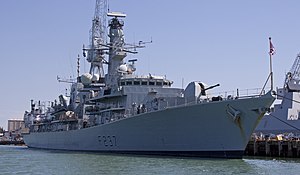HMS Westminster (F237)

HMS Westminster, 2011
|
|
| History | |
|---|---|
|
|
|
| Name: | HMS Westminster |
| Operator: | Royal Navy |
| Ordered: | December 1989 |
| Builder: | Swan Hunter, Tyne and Wear, United Kingdom |
| Laid down: | 18 January 1991 |
| Launched: | 4 February 1992 |
| Commissioned: | 13 May 1994 |
| Refit: | October 2014 |
| Homeport: | Portsmouth |
| Motto: | For Nation and for Glory |
| Status: | in active service |
| Badge: |  |
| General characteristics | |
| Class and type: | Type 23 Frigate |
| Displacement: | 4,900 t (4,800 long tons; 5,400 short tons) |
| Length: | 133 m (436 ft 4 in) |
| Beam: | 16.1 m (52 ft 10 in) |
| Draught: | 7.3 m (23 ft 9 in) |
| Propulsion: |
|
| Speed: | In excess of 28 kn (52 km/h; 32 mph) |
| Range: | 7,500 nautical miles (14,000 km) at 15 kn (28 km/h) |
| Boats & landing craft carried: |
2x PAC 24 RIBs |
| Complement: | 185 (accommodation for up to 205) |
| Sensors and processing systems: |
Sonar 2087 |
| Electronic warfare & decoys: |
|
| Armament: |
|
| Aircraft carried: |
|
| Aviation facilities: |
|
HMS Westminster is a Type 23 "Duke"-class frigate of the Royal Navy, and the second ship to bear the name. She was launched on 4 February 1992 and named for the Dukedom of Westminster.
Westminster was used for the interior shots in the 1997 James Bond film Tomorrow Never Dies in three different roles – as HMS Chester, HMS Devonshire and HMS Bedford. For the exterior shots a model was constructed.
In 2004, Westminster was assigned one of the Royal Navy's first Merlin helicopters. Also in 2004, the ship was the first to be fitted with the new low-frequency Sonar 2087 designed to detect the most advanced submarines. The technology is controversial as its effects on marine wildlife remain unclear.
In December 2005, the ship's company of Westminster were all granted Freedom of the City of Westminster. 200 naval officers and sailors in full ceremonial uniform paraded through the streets of London from Westminster Abbey to Horse Guards as part of the celebration service. Westminster was chosen as a very rare recognition of her contributions to Westminster schools, local charities and the community as a whole. The honour entitles the crew the freedom to "parade through the City on all ceremonial occasions in full panoply and with drums beating, colours flying and bayonets fixed".
She was deployed to Burma in May 2008 to spearhead the British relief effort after Cyclone Nargis devastated the country, but later had to withdraw after the junta refused to grant permission for aid to be landed.
In March 2011, Westminster took part in Operation Ellamy, the British role in the coalition action during the 2011 Libyan civil war by enforcing a naval blockade. She took part in Exercise Saxon Warrior in the Western Approaches with the US aircraft carrier George H.W. Bush in May 2011, culminating in a so-called 'Thursday War'.
...
Wikipedia
